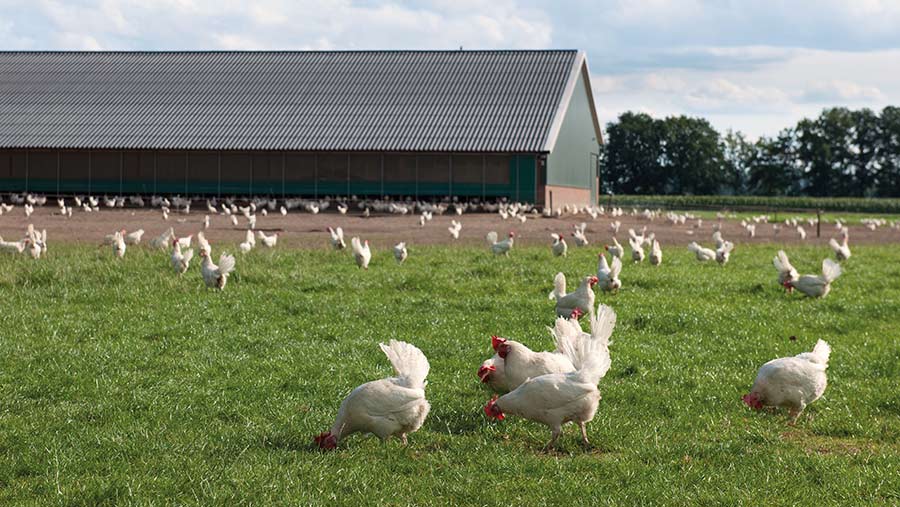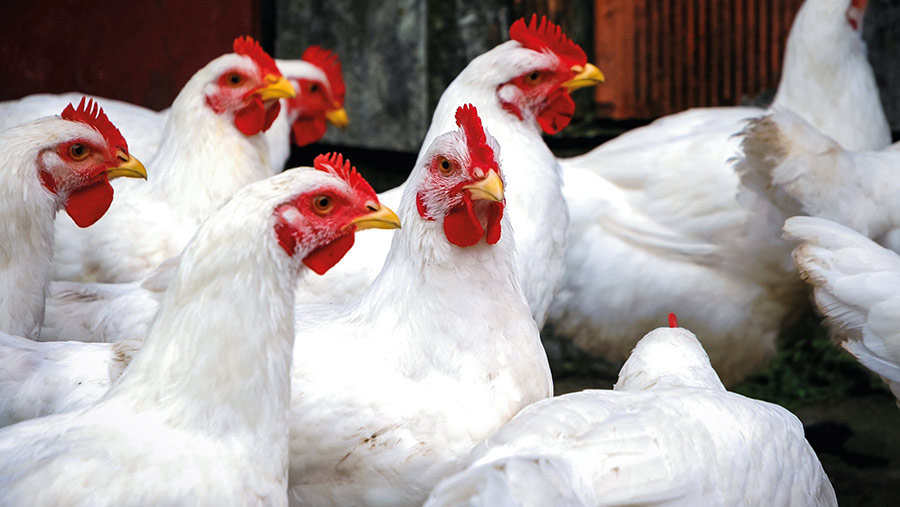What to consider before extending layer life beyond 72 weeks
 © Ivonne Wierink/Adobe Stock
© Ivonne Wierink/Adobe Stock Genetic advances and meticulous health and welfare management mean it is now more viable for egg producers to extend layer life – and the rewards can be considerable. So how should producers go about it?
Taking free-range layers past the standard 72 weeks requires careful planning, which begins before chicks are even hatched, says Matt Balfour, regional lead vet at St David’s Poultry Team.
“Layer breeders have made substantial genetic gains over the past 10-15 years. Birds are now more suited to the free-range environment, but other factors – including chick quality – will have an impact on how long you can profitably take birds.”
See also: 5 areas that can optimise feed efficiency in layer flocks
Genetics and parent flock
From a genetic perspective, a focus on monitoring laying at the end of the cycle over the past 20 years has produced birds that are capable of laying high numbers of first-quality eggs throughout the cycle.
This is explained by Nick Bailey, managing director at Joice and Hill Poultry, which works with Hendrix Genetics.
“The extension of pure line testing – from 60 to 80 weeks in 2000 and then to 100 weeks in 2008 – underpinned the effectiveness of the breeding programme.
“This created the scope to measure variations between selection candidates and their families, revealed by the longer period.”
Parent flock management, and a transparent relationship with the breeder, is essential, adds Mr Balfour.
Producers need to know chicks can reach full genetic potential, and any problems encountered in the parent flock phase should be communicated with the rearer, and subsequently with the farmer.
“Parent flocks need to be of good health status, providing the chick with the right nutrition and the right antibodies,” he says.
“A healthy, well-managed parent flock, with good hygienic egg collection, storage and hatching protocols, all form part of the longevity picture.”
Rearing focus areas
Once the chick is on the ground in the rearing unit, the onus is on the rearer to do the best job they can. “What we should be focused on at this stage is good early frame development,” explains Mr Balfour.
“Nutrition is key, with a range of supplements available to help the bird generate a good frame, allowing it to maximise its full potential in lay.”
“The different stages, and nutritional requirements as the bird moves through them, should be considered carefully,” says Martin Humphrey, director at Humphrey Feed and Pullets.
“Because you’re trying to push the envelope, the nutritional management of the bird needs to be adapted right from the start.
“Focusing on intestinal health all the way through lay is critical, and will help deliver the required egg and shell quality in lay.”
Environmental factors contribute to chick development, and attention to detail is important, adds Mr Balfour. Birds should be well spread through the shed, and disease challenges should be controlled to aid development of an even flock.
“Vital in this stage is a gold-standard vaccine programme, with proper application being essential,” he adds. “Birds must develop strong immunity to diseases like infectious bronchitis [IB], salmonella and E coli.”
Mr Balfour advises producers to contact their vets to create a tailored vaccine package to meet the flock’s specific needs.
As with the parent flock phase, if there has been an issue during rearing, farmers must be told so they can assess potential flock lifespan.
“Finally, careful transfer of birds needs to be respected. Rough handling will result in stressed birds and an uneven flock.”

© Fotokon/Adobe Stock
In the laying shed
Once in the laying shed, pre-lay ration is important. “It helps build the correct calcium metabolism pathways,” explains Mr Balfour.
“If you give them a peak laying ration as soon as they come in, their ability to metabolise calcium properly is reduced.”
This is the set-up phase for the flock, says Mr Humphrey.
“Strategy depends upon the season and what your packer wants in terms of egg profile and size.
“The short day length in midwinter can allow the use of a pre-lay diet, which helps the bird transition between the grower and first layer diet.
“The longer day length in the summer usually encourages the bird to come into lay more quickly, so there is insufficient time for pre-lay,” he adds.
“Instead, an early lay diet with higher protein, good amino acid levels, and lower energy is required to develop appetite – an increase from grower levels of circa 80g/day to 120g/day of a bird in lay.
“High phosphorous and medium calcium levels will also assist with eggshell development.”
In mid-production, producers need to look at controlling egg size by reducing protein and amino acids, while maintaining energy. “Calcium levels should be increased to retain shell quality,” says Mr Humphrey.
Come late lay, a delicate balance needs to be struck. “Consider further protein reductions, as the bird will use valuable energy removing any excess.
“Methionine should be carefully managed, so as not to encourage growth in egg size. Calcium should be increased again to support egg quality.”
Nutritional and nutraceutical advances have certainly armed producers to take birds longer, says Mr Balfour. “We have a better idea of what birds need nutritionally, and there are more products available to boost egg quality.”
Enhancing intestinal health throughout lay will provide significant benefit in terms of productive lifespan. “Probiotics and encapsulated organic acids are useful additions to consider in the diet throughout lay.”
At 50-60 weeks supplements to maintain shell and egg quality should be introduced. “That’s not just extra oyster shell. Have a discussion with your nutritionist about which products will improve calcium metabolism in late lay.”
As birds move through the laying cycle, producers need to keep on top of vaccinations.
“I would encourage all farmers to run an IB vaccination programme throughout lay,” says Mr Balfour. “That will help maintain egg quality as the IB virus can damage the oviduct.
“I would also recommend a live E coli booster, and ideally both vaccines should be tailored to your specific site, considering multi-age sites, how old infrastructure is, and disease history profile.
“What we’re looking to achieve is a nice, consistent platform for the bird to produce off.”
Parasite control, water hygiene and biosecurity
Failure to maintain high health standards could negate other efforts to lengthen the productive lifecycle of a flock – and that includes adopting a proactive approach to parasite control,” warns Mr Balfour.
“Whether it’s worming or red mite, if you wait to see clinical signs, the damage is already done. Compromised gut integrity and stress will knock immune function, and such checks will diminish productive lifespan.”
Maintaining water hygiene is essential. “Most systems run off a borehole or mains supply,” he explains.
But just because the water coming into the shed is clean, doesn’t mean the water getting to the birds is clean. Regular testing at the end of drinker lines is required.
“We frequently see biofilm build up within the lines, which at the very least is affecting gut health and feed conversion rates. In severe cases, it may be killing birds through E coli transmission.
“Flushing lines bi-weekly with a hydrogen peroxide-based cleaner will help maintain a clean water supply. Alternatively, there are systems that constantly feed a low dose into drinking lines, keeping them clean.”
Biosecurity measures must be rigorous, as the opportunity for bringing in disease is greater given the longer production window, says Mr Balfour.
“Biosecurity must be taken seriously. Bringing in E coli, mycoplasma, pasteurella, or erysipelas will limit the productive lifecycle of the flock. And if you need to depopulate early, you may have a longer than normal wait for replenishment.”
The economic benefits
The numbers behind extended laying periods are beginning to add up, says Mr Humphrey.
“With the drive for ever larger eggs waning, the differential payment between large and medium eggs is now smaller. Medium eggs mean a more sustainable bird, so the economics of taking birds further makes sense.”
According to Mr Balfour, several producers are now taking both white and brown hens to 100 weeks, with the following benefits:
- Greater total egg numbers per bird
- Reduction in pullet depreciation
- Restocking less frequently
- Reduced turnaround cost
- Less downtime for infrastructure
- Fewer male chicks being destroyed
- Fewer vehicle movements.
Top-performing flocks are maintaining an 85-90% production level at 80 weeks, with mortality below 0.1% per week.
Even based on taking a flock to 80 weeks, the economic benefits can be significant, equating to as much as £60,000 across 32,000 birds – or £139,000 when taking them to 90 weeks.
How the numbers stack up |
|
| Pullet cost (£) | 5.21 |
| Total number of birds | 32,000 |
| Feed cost per tonne (£) | 380 |
| Feed rate (g) a bird a day | 126 |
| Eggs a bird a week | 6 |
| Egg price/doz (£) | 1.15 |
| Additional weeks | 8 |
| Laying period (weeks) | 56 |
| Depreciation a bird a week over 56 weeks (£) | 0.09 |
| Feed cost a bird a week (£) | 0.34 |
| Egg income a bird a week (£) | 0.58 |
| Additional income a bird a week (£) | 0.24 |
| Additional value per pullet (£) | 1.92 |
| Total benefits (£) | 61,399.04 |
| Source: St David’s Poultry Team | |
